Jupiter Shines in Scientific and Artistic Images by Citizen Scientists (Gallery)
Jupiter with Clouds
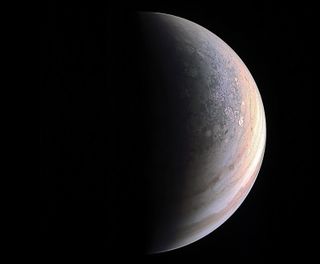
Early images of Jupiter taken by the JunoCam instrument on NASA's Juno probe have been made available to the public. (Juno is getting closer to Jupiter than any other probe in history). Citizen scientists have taken the raw images and processed them in various ways. Some of the images highlight certain features, while others are gorgeous works of art. J. Major, who created this image, wrote, "A tweaked version of the released image of Jupiter, enhancing some cloud detail while removing banding tones."
This slideshow was updated on Jan. 14, 2017.
A Crescent Jupiter
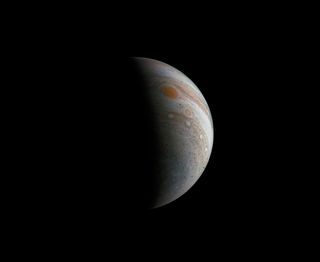
Using data from NASA's Juno spacecraft, citizen scientist Roman Tkachenko created this photo of a half-lit Jupiter. Tkachenko used JunoCam data to create this image.
"You can also see a series of storms shaped like white ovals, known informally as the 'string of pearls.' Below the Great Red Spot a reddish long-lived storm known as Oval BA is visible," NASA officials wrote in an image description.
Jupiter in Full View
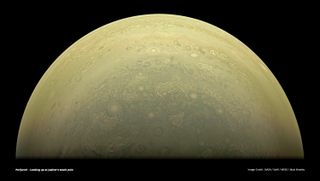
JunoCam participant Matt Brealey wrote about this image: "An image constructed from the perijove 1 raw images, using common Visual Effects techniques, in The Foundry's 'Nuke' compositing software."
Stormy Weather
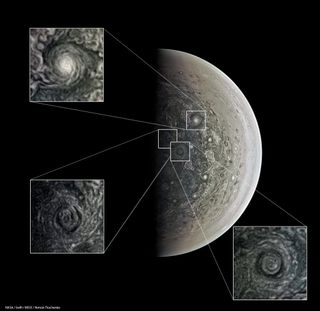
Citizen scientist Roman Tkachenko provides a zoomed-in view of some of the storms on Jupiter's south pole.
Jupiter landscapes
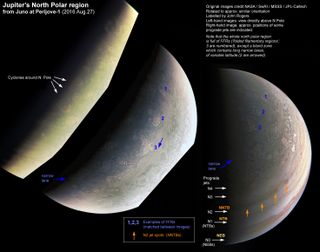
This mage provides a guide to some of the features seen on Jupiter by the JunoCam. Citizen scientist John Rogers, who created the image, writes, "In this longitude range, we cannot identify any individual far-northern features tracked from Earth. The whole region is almost filled with cyclonic turbulent regions ('folded filamentary regions,' FFRs), better resolved than by previous spacecraft. Novel features are: long, narrow cloud lanes in an otherwise bland zone; a cluster of cyclones (to judge from their spiral structure) immediately around the north pole. At least three are visible on the sunlit side, and the north pole itself is not illuminated. They are reddish. On Saturn, Cassini has revealed that there is a single mega cyclone precisely at each of the poles. On Jupiter, Juno's camera now suggests that there are multiple cyclones clustered around each of the poles."
Jupiter Map from JunoCam
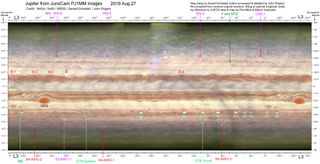
This detailed image is a collaboration between image processor Gerald Eichstädt and astronomer John Rogers. Rogers writes: "This map of Jupiter on August 27 was produced from the JunoCam images just before and after perijove-1, mainly by Gerald Eichstädt. The northern hemisphere is from inbound images from 03:45 to 13:58 (UTC at the spacecraft), and the southern hemisphere is from outbound images from Aug.27, 19:15 to Aug.28, 04:45. The map has been generated by collaboration of many amateurs using the data from NASA’s Juno team. Gerald Eichstädt processed and projected the JunoCam images and converted them into maps. Because images of this oblate planet taken from such high latitudes and phase angles had never before been used to make a map, it was difficult to achieve accurate coordinates, so I checked the longitude scale of the map by reference to amateur data: charts from the JUPOS team up to August, and a map made by Marco Vedovato from infrared images taken by Phil Miles on Aug.26-28. The latter images (and those by Anthony Wesley) were especially important for accurate alignment. Gerald and I then re-compiled the map and adjusted the colours and intensities to enhance visibility of features." This is the version of the image with major features labelled.
Hurricane on Juno
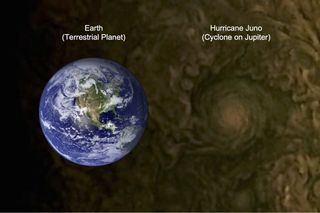
Citizen scientist Alex Longo writes: "This is an image of Jupiter's south pole (enhanced with increased contrast) cropped to center on a large storm. It is a cyclone similar to hurricanes on Earth, likely caused by two opposing jet streams. However, this hurricane is massive - 2/3 the size of the Earth! Our home planet is included for scale."
Eye of the Beholder
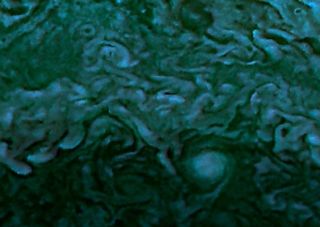
Some people have been making art out of the scientific data, as with this image created by Alex Longo, who wrote, "By changing the color of Juno's view of Jupiter's south pole and cropping, I was able to make an image similar to Vincent van Gogh's 'Starry Night' painting, showing that the universe is full of artistic and beautiful sights."
Data or Modern Art

This image was made as an attempt to "highlight certain clouds" according to the citizen scientist who processed this image (username Alessio-08); the result looks like a modern art piece.
Purple Jupiter
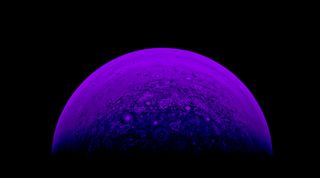
This image, processed by JunoCam participant SNO-80, brings out the blue and purple wavelengths captured by JunoCam.
Artful rendering
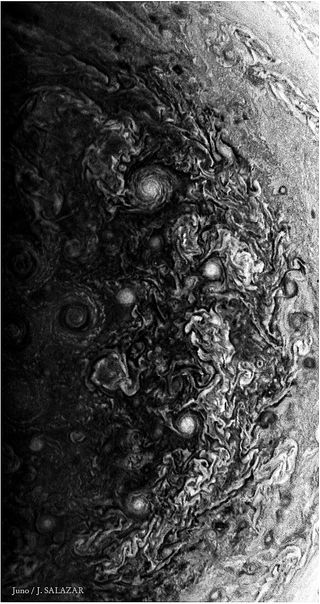
User Timmerman-61 created this artistic image.
Follow Calla Cofield @callacofield. Follow us @Spacedotcom, Facebook and Google+.
Join our Space Forums to keep talking space on the latest missions, night sky and more! And if you have a news tip, correction or comment, let us know at: community@space.com.
Get the Space.com Newsletter
Breaking space news, the latest updates on rocket launches, skywatching events and more!

Calla Cofield joined Space.com's crew in October 2014. She enjoys writing about black holes, exploding stars, ripples in space-time, science in comic books, and all the mysteries of the cosmos. Prior to joining Space.com Calla worked as a freelance writer, with her work appearing in APS News, Symmetry magazine, Scientific American, Nature News, Physics World, and others. From 2010 to 2014 she was a producer for The Physics Central Podcast. Previously, Calla worked at the American Museum of Natural History in New York City (hands down the best office building ever) and SLAC National Accelerator Laboratory in California. Calla studied physics at the University of Massachusetts, Amherst and is originally from Sandy, Utah. In 2018, Calla left Space.com to join NASA's Jet Propulsion Laboratory media team where she oversees astronomy, physics, exoplanets and the Cold Atom Lab mission. She has been underground at three of the largest particle accelerators in the world and would really like to know what the heck dark matter is. Contact Calla via: E-Mail – Twitter